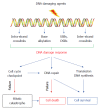DNA damage responses in cancer stem cells: Implications for cancer therapeutic strategies
- PMID: 26322164
- PMCID: PMC4549769
- DOI: 10.4331/wjbc.v6.i3.57
DNA damage responses in cancer stem cells: Implications for cancer therapeutic strategies
Abstract
The identification of cancer stem cells (CSCs) that are responsible for tumor initiation, growth, metastasis, and therapeutic resistance might lead to a new thinking on cancer treatments. Similar to stem cells, CSCs also display high resistance to radiotherapy and chemotherapy with genotoxic agents. Thus, conventional therapy may shrink the tumor volume but cannot eliminate cancer. Eradiation of CSCs represents a novel therapeutic strategy. CSCs possess a highly efficient DNA damage response (DDR) system, which is considered as a contributor to the resistance of these cells from exposures to DNA damaging agents. Targeting of enhanced DDR in CSCs is thus proposed to facilitate the eradication of CSCs by conventional therapeutics. To achieve this aim, a better understanding of the cellular responses to DNA damage in CSCs is needed. In addition to the protein kinases and enzymes that are involved in DDR, other processes that affect the DDR including chromatin remodeling should also be explored.
Keywords: Cancer stem cell; Cancer therapy; DNA damage response; DNA repair.
Figures

Similar articles
-
DNA Repair and Therapeutic Strategies in Cancer Stem Cells.Cancers (Basel). 2023 Mar 22;15(6):1897. doi: 10.3390/cancers15061897. Cancers (Basel). 2023. PMID: 36980782 Free PMC article. Review.
-
Molecular Pathogenesis of Radiation-Induced Cell Toxicity in Stem Cells.Int J Mol Sci. 2017 Dec 18;18(12):2749. doi: 10.3390/ijms18122749. Int J Mol Sci. 2017. PMID: 29258244 Free PMC article. Review.
-
Targeting therapy-resistant cancer stem cells by hyperthermia.Int J Hyperthermia. 2017 Jun;33(4):419-427. doi: 10.1080/02656736.2017.1279757. Epub 2017 Feb 2. Int J Hyperthermia. 2017. PMID: 28100096
-
Therapies targeting cancer stem cells: Current trends and future challenges.World J Stem Cells. 2015 Oct 26;7(9):1185-201. doi: 10.4252/wjsc.v7.i9.1185. World J Stem Cells. 2015. PMID: 26516409 Free PMC article. Review.
-
The Targeting of MRE11 or RAD51 Sensitizes Colorectal Cancer Stem Cells to CHK1 Inhibition.Cancers (Basel). 2021 Apr 19;13(8):1957. doi: 10.3390/cancers13081957. Cancers (Basel). 2021. PMID: 33921638 Free PMC article.
Cited by
-
An ankyrin-binding motif regulates nuclear levels of L1-type neuroglian and expression of the oncogene Myc in Drosophila neurons.J Biol Chem. 2018 Nov 9;293(45):17442-17453. doi: 10.1074/jbc.RA118.004240. Epub 2018 Sep 26. J Biol Chem. 2018. PMID: 30257867 Free PMC article.
-
Cell Cycle Changes after Glioblastoma Stem Cell Irradiation: The Major Role of RAD51.Int J Mol Sci. 2018 Oct 3;19(10):3018. doi: 10.3390/ijms19103018. Int J Mol Sci. 2018. PMID: 30282933 Free PMC article.
-
DNA Damage Responses, the Trump Card of Stem Cells in the Survival Game.Adv Exp Med Biol. 2024;1470:165-188. doi: 10.1007/5584_2023_791. Adv Exp Med Biol. 2024. PMID: 37923882 Review.
-
Chemokines orchestrate tumor cells and the microenvironment to achieve metastatic heterogeneity.Cancer Metastasis Rev. 2021 Jun;40(2):447-476. doi: 10.1007/s10555-021-09970-6. Epub 2021 May 6. Cancer Metastasis Rev. 2021. PMID: 33959849 Free PMC article. Review.
-
Boric Acid Alters the Expression of DNA Double Break Repair Genes in MCF-7-Derived Breast Cancer Stem Cells.Biol Trace Elem Res. 2024 Sep;202(9):3980-3987. doi: 10.1007/s12011-023-03987-4. Epub 2023 Dec 12. Biol Trace Elem Res. 2024. PMID: 38087035
References
-
- Clarke MF, Dick JE, Dirks PB, Eaves CJ, Jamieson CH, Jones DL, Visvader J, Weissman IL, Wahl GM. Cancer stem cells--perspectives on current status and future directions: AACR Workshop on cancer stem cells. Cancer Res. 2006;66:9339–9344. - PubMed
-
- Mandal PK, Blanpain C, Rossi DJ. DNA damage response in adult stem cells: pathways and consequences. Nat Rev Mol Cell Biol. 2011;12:198–202. - PubMed
-
- Bao S, Wu Q, McLendon RE, Hao Y, Shi Q, Hjelmeland AB, Dewhirst MW, Bigner DD, Rich JN. Glioma stem cells promote radioresistance by preferential activation of the DNA damage response. Nature. 2006;444:756–760. - PubMed
-
- Farrell N. Current status of structure-activity relationships of platinum anticancer drugs: activation of the trans geometry. Met Ions Biol Syst. 1996;32:603–639. - PubMed
Grants and funding
LinkOut - more resources
Full Text Sources
Other Literature Sources

